Sonny, a handsome four-year-old German Shepherd who’s a K-9 officer at the Clinton Police Department, likes to go to work.
In a demonstration of his skills, Sonny’s human partner, officer Jason Frey, hid a sample of heroin in a box of files located in a storage attic at the police station. In about 30 seconds flat, Sonny ran up the stairs and located the illicit substance, sitting down in front of the file box. Then he claimed his pay: a minute with the tug toy, dragging Frey around the attic in a rolling office chair.
Frey says Sonny is a “fur missile,” 68 pounds of pure muscle and motivation, and one of the Clinton Police Department’s most valuable assets. This striking German Shepherd is also the toast of Instagram, with some 45,000 followers. He’s also been featured on the cover of Working Dog Magazine.
On Sonny’s Instagram account, Frey chronicles the joys and challenges of being, and training, a working dog. He posts glamour shots of Sonny and videos depicting the endless practice of bite work, tracking and obedience that it takes to be a police dog.
In addition to finding illegal drugs, Sonny can serve as a major deterrent to crime. Recently, Frey was called to a home in which a suspect had barricaded himself.
“There is nothing more satisfying to a dog than a street bite,” Frey explains. “Sonny can tell the difference between a training exercise and the real thing. He senses the adrenaline from me when I’m about to release him on someone. We opened the door just enough for Sonny’s face to poke in. He [the suspect] took one look and gave up instantly.”
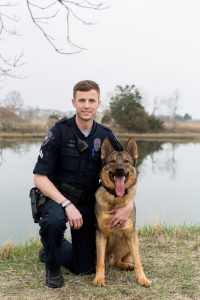
Working dogs are also an asset in searching for evidence. When a Clinton homeowner reported missing jewelry, Sonny was called to the scene and within five minutes, found the jewelry boxes discarded in piles of leaves on the property. That led to finding fingerprints on the boxes and, ultimately, an arrest.
Sonny came to Clinton from the Fidelco service dog program and was named for George “Sonny” Whelen, the CEO of Whelen Engineering, the company that designs and manufactures emergency lights for police vehicles. The company made a donation to purchase the dog, and Frey visits the business with Sonny about once a month. Sonny also makes appearances at community events.
“Sonny does community outreach and public relations, so we needed a dog that was socialized to people,” Frey says. “We run primarily on donations, so Instagram is a big part of that. The town did not want to fund a K-9 unit.”
Clinton allocates about $2,000 to the K-9 program and it costs more like $10,000 to feed Sonny his raw diet and pay for veterinary care, which is discounted by Clinton Veterinary Hospital, and to pay for training equipment like the bite sleeve and bite suit. Frey also sold T-shirts and other Sonny merchandise to help fund the unit.
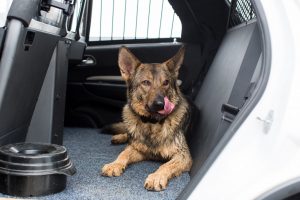
When he’s not on the job, Sonny lives at home with Frey and his family, sleeps in a crate and has no toys.
“He’s got to earn the toy; it’s his reward for completing a task,” Frey said. “And his prey drive wants to make him eviscerate that toy.”
A toy is a lower-level reward, followed by a tug toy, a nip on a bite sleeve, a chomp on the bite suit, and the ultimate – biting an actual bad guy. Frey has a few scars on his hands from the bite training.
Most of Connecticut’s police dogs are born in Eastern European countries, bred for the characteristics desirable in a working dog: the instinct to hunt, to chase prey, and to defend and protect the pack.
German Shepherds are the breed of choice, with the Belgian Malinois coming into favor. These so-called “green dogs” [untrained] attend a 16-week state police training academy with their handlers for eight hours a day, five days a week, according to Berlin officer Aimee Krzykowski. K-9 and handler head back to the academy once a month for additional training but work daily on reinforcing obedience and tracking commands.
The dogs are trained in detecting the presence of the odor of an illegal narcotic, searching for illegal drugs, stopping suspects from fleeing, and sniffing out evidence. Some dogs are trained to detect explosives; those would not be trained in narcotics. All the commands, like “sitz” (sit) and “plotz” (lie down), are German.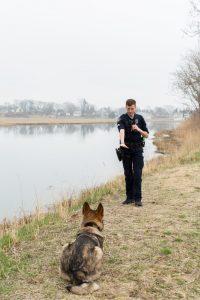
“Commands are given in German to avoid any confusion with commands I give to suspects,” Frey said. “For example, if I tell a suspect to get down on the ground, I don’t want Sonny to hear the word ‘down’ and do something that I don’t want him to do. That, and so nobody else can really give him any commands.”
Most dogs work until they are about 10 years old and must pass a recertification test every year.
In Berlin, residents often drop off dog toys for Casner, Krzykowski’s black, three-year-old German Shepherd K-9 partner.
“Casner is an amazing deterrent. He’s got a big bark and a commanding presence,” Krzykowski says. “We don’t know how many crimes he prevents.”
Casner – named for Berlin officer Jeffery Casner, who was killed by a drunk driver while on duty – travels in the back of a police SUV in a specially designed metal cage that protects him. Brady’s K-9 Fund, a non-profit started by a nine-year-old Ohio boy, will supply Casner with a lightweight ballistic and stab-proof vest that he can wear throughout his entire shift, as opposed to one that needs to be taken off and on. The vests typically cost more than $1,000.
Training in obedience in the parking lot of the Berlin police department recently, Casner never took his eyes off Krzykowski, even when she walked behind a parked car. The human and canine bond is strong.

A two-time breast cancer survivor, Krzykowski got a lot of comfort from both Titan, her retired K-9 who lives with her, and Casner.
“When I was a couple of days out of chemo, and I didn’t feel like it, they got me up and moving,” Krzykowski says. “It gave me some sense of normalcy and was the best thing for me,” she says.
The New Haven Police Department has a relatively large contingent of K-9 officers: six patrol dogs including two Belgian Malinois, four German Shepherds, and one explosives-trained Labrador Retriever. Several of the dogs were funded through grants.
It’s a busy department with lots of requests for dogs to search for weapons, drugs and other evidence as well as finding lost children and seniors.
Officer Joe Staffieri is especially proud of Magnum, his five-year-old German Shepherd, for finding a gun hidden in a pile of leaves in the backyard of a home that a suspect had thrown away 12 hours earlier.
“There was play equipment in that yard,” Staffieri says. “God forbid one of the kids had found the gun.”
Dogs are particularly useful in finding the bad guy hiding behind a door in a building.
“We would rather have the dog go in first than risk the safety of an officer,” Staffieri says.
K-9 programs are increasingly supported by the public.
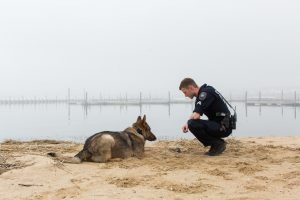
Lisa Deane, a Madison resident who lost her son Joe to a fentanyl overdose last December, founded demandZERO, an organization dedicated to combating the opioid epidemic. The group recently raised more than $80,000 at a charity auction and is working toward donating a dog and funds for food and veterinary care to the New Haven Police Department.
“Joe was a wonderful kid and an exceptional athlete, but he suffered with the addiction,” Deane says. “He fought it with all he had and died of a pure fentanyl overdose. Joe loved dogs but feared the drug detection dogs. We asked the police about the best way to support them. Our mission is to help law enforcement fight the opioid epidemic.”
This spring, Deane fought for the passage of a law stiffening the penalties for selling fentanyl, a synthetic opioid. Gov. Lamont signed the bill in June.
Photography by Allegra Anderson


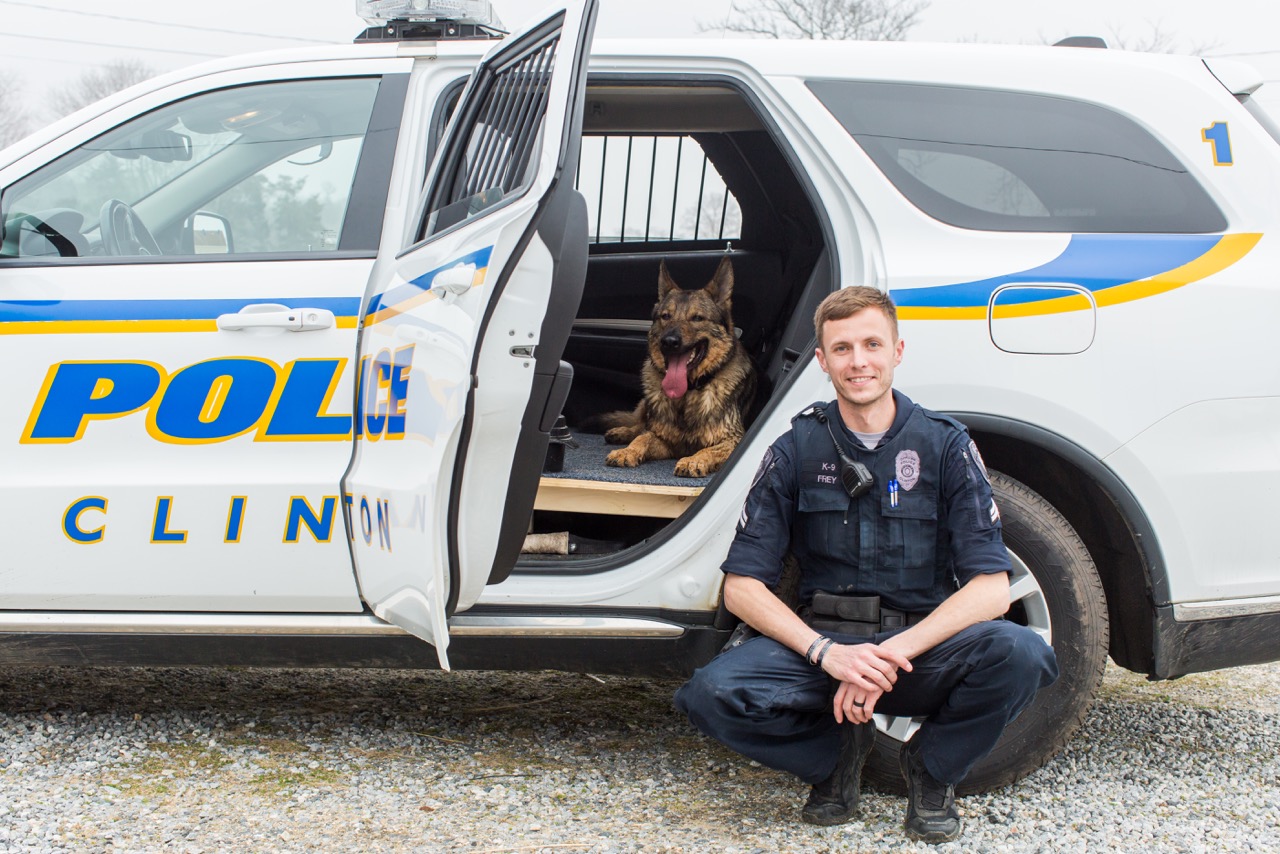





More Stories
Over 50, Underestimated: The Grandfluencers Redefining Age on Social Media
Building Resilient Businesses: Strategies for Success
Summer Means Convertibles